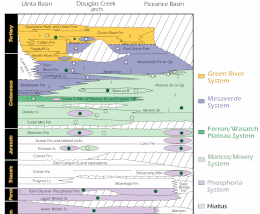Contents
The Ferron Sandstone Member of the Mancos Shale is a geologic unit in Utah. It preserves fossils dating back to the Cretaceous period; and more specifically the middle Turonian.[1]
[2] Named by Lupton (1916), the formation is readily divisible into upper and lower members on the basis of both lithologic character and depositional history. Tectonic rejuvenation of adjacent provenance areas near the present Mount Nebo and Fish Lake Plateau shed coarser clastics eastward into the shallow seaway. This resulted in deposition of the widespread and persistent basal regressive marine sandstone of the Ferron.
Description

The Ferron Sandstone Member is bracketed by the overlying Blue Gate member of the Mancos Shale and the underlying Tununk Member of the Mancos Shale. It is composed of alternating yellow-gray, light-brown, and white sandstone, sandy gray shale, gray and carbonaceous shale, and coal. The sandstone is mostly fine to medium grained, calcareous, lenticular, thin to very thick bedded. It forms a resistant cliff above Tununk Member. The Ferron is 120 to 215 meters (400–700 ft) thick, thickening to the southwest.[3] It is believed to represent flood dominated, marine-current and wave influenced deltas that drained the Cretaceous landscape.[4]
Paleontology
A diverse collection of 13 species of shark teeth from the lower part of the Ferron Sandstone include: Hybodus sp., Ptychodus cf. P. mammillaris Agassiz, 1843, Ptychodus whipplei Marcou, 1858, cf. Chiloscyllium sp., Scapanorhynchus raphiodon (Agassiz, 1843), Cretodus crassidens (Dixon, 1850), cf. Leptostyrax sp., cf. Cretalamna appendiculata (Agassiz, 1835), Squalicorax sp., Pseudohypolophus mcnultyi (Thurmond, 1971), Protoplatyrhina hopii Williamson, Kirkland and Lucas, 1993, Ischyrhiza schneideri (Slaughter and Steiner, 1968), and Ptychotrygon triangularis (Reuss, 1844). The assemblage is typical of Turonian shark fauna.[5]
A trackway made by a medium-sized ornithopod is known near the Moore Road Cutoff near the type section.[6] Other vertebrates include a pteranodontoid pterosaur represented by wing bones,[7] crocodilian teeth, a turtle shell fragment, and a small ornithopod ilium.[8]
Fossil plants include giant 1.8 m diameter log of the angiosperm Paraphyllanthoxylon, angiosperm leaves, and shoots of the confier Elatides curvifolia.[8] These fossils indicate a mixed forest of angiosperm and conifer forests on the Turonian deltas.
See also
References
- ^ USGS summary of "Significant Publications" on the Ferron Ss: https://ngmdb.usgs.gov/Geolex/UnitRefs/FerronRefs_8105.html
- ^ Hale, Lyle, A. (1972). "Depositional History of the Ferron Formation, Central Utah". Plateau - Basin and Range Transition Zone, Central Utah, 1972: 29–40 – via AAPG Datapages/Archives.
{{cite journal}}: CS1 maint: multiple names: authors list (link) - ^ "Utah Geological Survey online interactive geologic map".
- ^ Fielding, C.R., 2010. Planform and facies variability in asymmetric deltas: facies analysis and depositional architecture of the Turonian Ferron Sandstone in the western Henry Mountains, south-central Utah, USA. Journal of Sedimentary Research, 80(5), pp.455-479.
- ^ Becker, M.A., Wellner, R.W., Mallery, C.S. and Chamberlain, J.A., 2010. Chondrichthyans from the Lower Ferron Sandstone Member of the Mancos Shale (Upper Cretaceous: Middle Turonian) of Emery and Carbon Counties, Utah, USA. Journal of Paleontology, 84(2), pp.248-266.
- ^ Jones, R.A.M.A.L., 2001, September. Dinosaur trackway from the Ferron Sandstone Member of the Mancos Shale Formation (Upper Cretaceous) of central Utah. In Proceedings of the 6th Fossil Resource Conference. Lakewood, National Park Service, Geological Resources Division (pp. 48-51).
- ^ Bennett, S.C., 2018. A large pterodactyloid pterosaur from the Late Cretaceous Ferron Sandstone of Utah. Geological Society, London, Special Publications, 455(1), pp.187-193.
- ^ a b Jud, N.A., Michael, D.D., Williams, S.A., Mathews, J.C., Tremaine, K.M. and Bhattacharya, J., 2018. A new fossil assemblage shows that large angiosperm trees grew in North America by the Turonian (Late Cretaceous). Science advances, 4(9), p.eaar8568.
- Various Contributors to the Paleobiology Database. "Fossilworks: Gateway to the Paleobiology Database". Archived from the original on 25 March 2022. Retrieved 17 December 2021.

